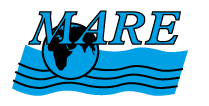A program of the Lawrence Hall of Science that seeks to increase ocean literacy through informal and formal education initiatives
Periodic Table of the Fishes
Listing of 89 fish, with color illustrations and calorie counts, in the style of the periodic table of elements.
Sharks and Other Creatures
Illustrations of about 15 sharks, along with their adult sizes and scientific names.
Tracking Trash: Flotsam, Jetsam, and the Science of Ocean Motion (Scientists in the Field)
School Library Journal : Starred Review.
Waterman's Boy
Two boys from a small town on the Chesapeake Bay help a scientist interested in cleaning up the water for the benefit of animals, plants, and people, while risking parental disapproval of people with too much education and of outsiders’ interference in their means of earning a living.
Just a Dream
When he has a dream about a future Earth devastated by pollution, Walter begins to understand the importance of taking care of the environment. Unique and evocative pictures of what our future may hold provide the powerful backdrop as young Walter becomes enlightened and changes his thinking and actions.
Island of the Blue Dolphins
Left alone on a beautiful but isolated island off the coast of California, a young Native American girl spends eighteen years, not only merely surviving through her enormous courage and self-reliance, but also finding a measure of happiness in her solitary life. Interwoven are descriptions of the island, of fish and ocean vegetation, animals and plants. The way she interacts with nature to survive, hunt, build shelter, and design clothing, both as she had been taught by her people and as she develops her own technological and artistic skills, is a particularly strong aspect of the book.
The Great Kapok Tree: A Tale of the Amazon Rain Forest
The many different animals that live in a great kapok tree in the Brazilian rainforest try to convince a man with an ax of the importance of not cutting down their home. Although this picture book is meant for a younger audience, it is useful to demonstrate that in the same way one tree in a forest is important to many other animals, one species in the ocean—like squid—are important to many other species in the ocean.
Tentacles: The Amazing World of Octopus, Squid and Their Relatives
This account of the cephalopods – octopus, squid, nautilus and cuttlefish – begin with the exciting account of a giant squid which, in 1872, dragged a ship below the surface of the sea, killing all on board. And throughout, the text combines exciting writing with factual information, describing hidden octopus watching scuba divers, squid moving “like living missiles” the vampire squid whose appearance resembles Dracula’s cape, the cuttlefish as quick-change artist.
Call it Courage
Based on a Polynesian legend, this chapter book for older students tells the story of a young boy who overcomes his fear of the sea and proves his courage to himself and his tribe. The story illustrates his culture’s connection to the ocean. The whole story or selected passages could be read aloud to early elementary students. Newbery medal winner.
Pages




